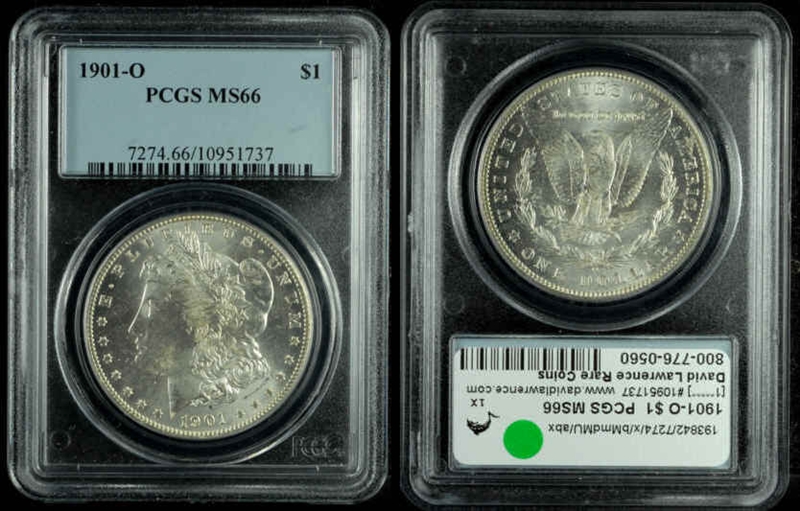1901-O $1 MS66 认证号10951737, PCGS号7274
专家评论
Q. David Bowers
The following narrative, with minor editing, is from my "Silver Dollars & Trade Dollars of the United States: A Complete Encyclopedia" (Wolfeboro, NH: Bowers and Merena Galleries, Inc., 1993)Numismatic Information
Hoard coins: After the New Orleans Mint ceased business, quantities of silver dollars were shipped to Washington, D.C. and Philadelphia for storage. From vaults in the Treasury Building in Washington, D.C., Uncirculated 1901-O dollars dribbled out onto the market from the early 1930s onward. Prior to that time, the 1901-O in Uncirculated grade was a major rarity, although in the absence of research on the subject few numismatists realized this.
In 1953, a major release occurred, followed by distributions through the mid-1950s. Obtaining coins indirectly from this source, Philip Maul, a Hudson, New York dealer, advertised rolls in The Numismatist in September 1953. In the September 1957 issue of The Numismatist, Harry J. Forman advertised that he had Uncirculated specimens of 1901-O available in quantity. In general, anyone who stocked Uncirculated dollars was apt to have a supply of this date.
Any quantities released in the 1950s paled into insignificance in October 1962, when a long-sealed vault in the Philadelphia Mint was opened, and countless thousands of sparkling, new 1901-O dollars were released.
Circulated grades: Worn 1901-O dollars are common and are of no commercial consequence, as so many Uncirculated coins exist. Many were destroyed in private silver melts of the late 1970s.
Mint State grades: Mint State coins are common, but most are poorly struck and are extensively bagmarked. My estimates follow: MS-60 to 62, 150,000 to 300,000; MS-63, 80,000 to 150,000; MS-64, 30,000 to 60,000; and MS-65 or better, 8,000 to 16,000.
Prooflike coins: Prooflike coins are available.
Thousands exist. While examples are sometimes are seen with cameo contrast, most are weakly struck and/ or bagmarked-not the sort of coin that would attract the connoisseur's eye. On the other hand, John Highfill reports seeing a number of well-struck, pleasing coins. This diversity of opinion indicates that cherrypicking is advised. True DMPL coins and perhaps six or seven times rarer. About 20% of extant DMPL coins grade higher than MS-64.
Varieties
SPACE, SMALL STARS
VAM C-3 REVERSE
Circulation strikes:
1. Breen-5682, VAM-1, 9, 20-22, 24-26, 29-32. Common. The new 3rd edition of VAM lists many more varieties than did earlier versions. If high-resolution optical comparators are ever employed to study Morgan dollar date and mintmark varieties, doubtless many hundreds of discoveries will be made. Now, most VAM numbers pertain to varieties with repunching or some other anomalous feature, not to very minute positional differences. For 1901-O, RW. Julian says 140 reverses were made from both hubs; clearly not all were used.
NEW OVER OLD HUB: DOUBLE OLIVE AT CLAW VAM C-4 OVER C-3 REVERSE
Circulation strikes:
1. C-4 reverse hub over C-3: VAM-3, 12, 14-18, 23, 27, 28. Previously unknown to all but a few specialists, the C-4/C-3 reverse is now plentiful, and the 3rd edition of VAM lists numerous varieties.
NEW REVERSE HUB: WIDE NECK/WING SPACE, LARGE STARS
VAM C-4 REVERSE
Circulation strikes:
1. Breen-5683, VAM-2, 4-8, others. Forms the majority of this date; positional and/or repunched varieties. Common Uncirculated.
Dies prepared: Obverse: Unknown; Reverse: 140 (per R.W. Julian).
Circulation strike mintage: 13,320,000; Delivery figures by month: January: 1,500,000; February: 620,000; March: 1,100,000; April: 1,550,000; May: 1,500,000; June: 1,100,000; July: 800,000; August: 200,000; September: 1,550,000; October: 1,000,000; November: 900,000; December: 1,500,000.
Estimated quantity melted: Probably millions under the 1918 Pittman Act and later private melts.
Availability of prooflike coins: Available, but often unsatisfactory in appearance. DMPL coins are about six or seven times rarer.
Characteristics of striking: Varies, but often weak. Known hoards of Mint State coins: Bags were released by the Treasury over a period of time, especially in 1953, and in very large quantity in 1962-1964.
Commentary
The 1901-O is common in Mint State, but well-struck high-grade coins are elusive. Largest dollar mintage from New Orleans.
Additional Information
Distribution of Dollars
The Annual Report of the Director of the Mint 1901, told of the distribution of dollars during the fiscal year: New Orleans:
In the mint July 1,1900,21,197,000; coinage, fiscal year 1901, 10,910,000; total, 32,107,000; transferred from mints to Treasury, 15,500,000; in mint July 1, 1901, 15,823,500; total, 31,323,500; distributed from mint, 783,500.
PCGS #
7274
设计师
George T. Morgan
边缘
Reeded
直径
38.10 毫米
重量
26.73 克
铸币数量
13320000
金属成分
90% Silver, 10% Copper
更高评级数量
133
评级较低的钱币数量
38687
地区
The United States of America
价格指南
PCGS 数量报告
拍卖 - PCGS 评级的
拍卖 - NGC 评级的
稀有性和存量估计 了解更多
| 所有评级 | 1332000 |
| 60或以上 | 225000 |
| 65或以上 | 11300 |
| 所有评级 | R-1.0 |
| 60或以上 | R-1.8 |
| 65或以上 | R-2.9 |
| 所有评级 | 94 / 117 TIE |
| 60或以上 | 89 / 117 TIE |
| 65或以上 | 87 / 117 TIE |
| 所有评级 | 94 / 117 TIE |
| 60或以上 | 89 / 117 TIE |
| 65或以上 | 87 / 117 TIE |





















